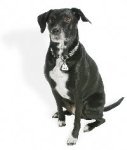Housebreaking an Adult Dog
It might seem like housebreaking adult dogs is more difficult than housetraining a puppy. This isn't necessarily true, and in fact many people find exactly the opposite - adult dogs have a longer attention span and can focus better, and training them is often easier than training a puppy. Sometimes older dogs that have been adopted from an animal shelter or humane society may never have been housetrained at all - some may never have even been inside a house before! Housebreaking adult dogs is not a complicated process, but it does require consistency, patience, and plenty of praise.
Before You Begin
- If your dog was reliably housetained previously and has now begun to have accidents, it's best to take him to the vet to check for any underlying medical conditions that may be causing him to eliminate inappropriately. Physical issues like kidney disease, Cushings Disease and liver disease can cause dogs to drink more and thus eliminate more. Canine cognitive dysfunction (dementia) may also cause dogs to forget their housetraining.
- Accidents will happen. Don't lose your temper or punish your dog. Clean the area very well, as dogs are always tempted to go where they can smell other urine or feces. Don't make a big deal of it, just clean up and get on with your day.
Let the Housetraining Begin!
 Designate an area where you want your dog to eliminate. This is
where you will always take her. Eventually, the goal is to give her a
vocal command and have her go their on her own to do her "business".
Designate an area where you want your dog to eliminate. This is
where you will always take her. Eventually, the goal is to give her a
vocal command and have her go their on her own to do her "business".
- Choose a verbal command. "Go pee!" or "Go poop!" is simple, but if you find that embarassing, choose something else (remember, you can use any words or combination of words you want -- even ones that don't make sense! -- so long as you use them consistently).
-
Take your dog several times a day. For instance, you might decide to take her out first thing in the morning, after breakfast, in the afternoon, after dinner, and before bedtime.
The goal is to make sure your dog never needs to go in the house at all, by giving her the opportunity to go outside before it occurs to her to let loose in the house. Pay attention to her body language - if you see her circling or sniffing, whisk her outside right away.
- Immediately bring your dog to the elimination area. Don't allow her to sniff this or that, or get side-tracked in any way. Take her straight to the spot, give her the verbal command, and wait. While she goes, repeat the verbal command so that she associates the command with what she is doing. After she finishes, praise her immediately - she should associate going outdoors with happy things. Let her know that you're pleased that she's eliminated outdoors.
- Supervise your dog. Don't give her a chance to
eliminate indoors if at all possible. You can confine her
to the same room that you're in, and watch her for signs
that she needs to go (ie. sniffing or circling).
If you have to leave her alone for a while, consider a crate or kennel. Don't make it too big, as you don't want your dog to divide the kennel into a "bedroom" and a "bathroom" area! It should be just large enough for her to stand, lie down, and turn around comfortably. When you return home, immediately take her outdoors to her elimination area, say the word, and praise her when she's done.
- If you catch her in the act of eliminating inside, do something to interrupt her. Don't scold her, although a firm 'No' is okay. Then take her outside to the same spot, give the verbal command, and say it again while she's eliminating. Praise her after she's done.
In many cases, housebreaking adult dogs is a faster and easier process than housebreaking a puppy. It's the same process, but adult dogs tend to be calmer and better able to focus and understand what you're asking of them. Remember that any kind of training takes time before the dog can understand what you are asking of them. Be patience, be cheerful, and your dog will try his best to please you!
